
Carbon Dioxide Hits Record High
This April marked a depressing milestone: the first time in recorded history that carbon dioxide concentration exceeded 410 parts per million.
This April marked a depressing milestone: the first time in recorded history that carbon dioxide concentration exceeded 410 parts per million. Atmospheric carbon dioxide levels, measured on top of Hawaii’s Mauna Loa Observatory, first hit 400 parts per million in 2013 and have since been steadily increasing. The concentration of carbon dioxide has risen from an initial 315 parts per million, when record keeping at the observatory began in 1958.
April’s record denotes a 30% increase in 60 years. Ice core samples from before the industrial revolution show that carbon dioxide levels fluctuated, but did not exceed 300 parts per million in the last 800,000 years. CO2 is increasing an average of 2.5 parts per million annually, a rate of increase 100 to 200 times faster than during the transition from the last ice age, according to NOAA.

410 is a long way off from the agreed goal of 350 parts per million. 350 was established as the upper limit by NASA scientist Dr. James Hansen who said that this target was critical to preserve our planet.
All around the world, we are seeing the impacts of global climate change driven by an increase in greenhouse gas emissions. This April, Pakistan set a record high temperature for the highest April temperature seen on Earth at 122.3 degrees Fahrenheit.
Ralph Keeling, head of the Scripps CO2 program at Scripps Institution of Oceanography in California, says that at our current pace we will hit 450 parts per million in about 16 years and exceed 500 parts per million in about 36 years. The impact to our planet and ecosystem could be catastrophic.
But there is still reason to be hopeful. Advancements in renewable energy are leading to more wind and solar coming online every day. While April marked a record high for carbon dioxide concentration, it also was a record for German solar power. From January to April, Germany produced over 10 billion kilowatt hours of solar power, the highest ever generated in a four-month period. In fact, the last week in April, more than 53% of all German energy came from renewable energy.
In the United States, solar power and wind made up 94% of new U.S. power generation for the first quarter of 2018. In the first three months of 2018, 16 wind farms and 92 solar projects came online, representing 53% and 40% of new capacity, respectively.
In New England, a sunny day on April 21, marked a record high for distributed solar. High amount of distributed solar drove down electricity demand, and New England customers ended up using more electricity from the grid while sleeping than in the middle of the day. ISO New England estimates more days like this can be expected in the spring and fall. While this was a first for New England, it is a common occurrence in sunny California.
Renewables also continue to become more cost competitive with traditional fossil fuels. A recent report by the International Renewable Energy Agency (IRENA) predicts that the cost of renewables will drop significantly by 2020, to a less expensive rate than fossil fuels.
It is tough to stay positive when atmospheric carbon levels seem to be rising with no end in sight. But the growth of solar and wind is a reason to be optimistic that we can start to push that trend in the opposite direction.
Mollie Simon
Senior Communications SpecialistMollie Simon is the senior communications specialist at the Kleinman Center. She manages the center’s social media accounts, drafts newsletters and announcements, writes and publishes content for our website, and regularly posts to our blog.

